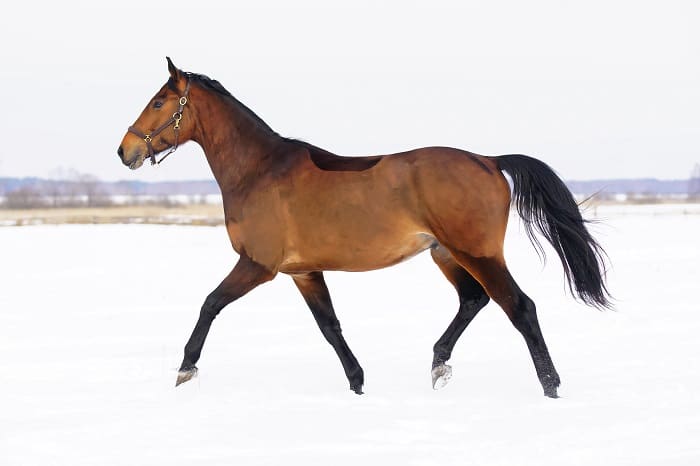Last Updated on December 23, 2021
Ever feel like you’re flying while riding a horse only to be told that the horse is going slow? You’re not alone! Speeds feel much different in the saddle than they do on your own two feet or in a car! But, how fast do horses walk?
So when you feel like you’re speeding around the arena or down the trail, how fast is your horse really going? Well, it depends on the horse, and it depends on the gait! Horses have multiple gaits and each one is accompanied by different average speeds.
In this article, I’ll be discussing the difference between a horse’s gaits, the average walking speed of a horse, and the average walking speeds of other animals, including humans!
How Fast Do Horses Walk: Horse Gaits
A normal horse has four gaits: the walk, the trot, the canter, and the gallop. There are some horses, called gaited horses, that have special and different gaits. Some of these gaits are called the rack, the tolt, and so on.
The basic four gaits are distinguished by speed, yes, but more importantly, they are distinguished by the pattern of movement. In other words, they are distinguished by when a horse puts which feet where.
Take the trot for example: at the trot, a horse moves diagonal pairs of legs simultaneously. It moves its right front and its left hind at the same time, and then swaps to its left front and its left hind. The trot is considered a two-beated gait because of this.
In contrast, the canter is considered a three-beated gait. The horse leads with one of its hind feet, then with the remaining diagonal pair, then the remaining front. Thus, three beats.
Depending on the level of collection or extension in the gaits, the trot and the canter can be the same speed. In extreme cases, the canter could even be slower than the trot. But, most commonly, the trot is slower than the canter.
Now, consider the walk. The walk is a four-beated gait, with the horse moving each foot individual of each other. The pattern is as follows: hind, opposite front, opposite hind, opposite front.
The walk is the slowest gait, though in some extreme cases of collection, one horse’s trot or even canter could be made slower than the walk. But, most frequently, the walk is the slowest gait, followed by the trot, followed by the canter, and of course followed by the gallop.
How Fast Do Horses Walk: Walking Speed
So now that we know the order of the speeds of gaits, we can begin to look at numbers. How fast do horses actually go? On average, a horse walks at a speed of four miles per hour. That’s not very fast at all!
This number can definitely alter between horses; larger horses might move faster than smaller horses, but depending on the horse, sometimes smaller horses will move faster than larger horses! It can also depend on the energy level of a particular horse, and whether the rider is asking for extension, collection, or neither.
So, when you’re “running” around the arena, you’re likely only going about four miles per hour. However, many things can contribute to you feeling like you’re going faster than you actually are.
One of these factors is the height of horses. Especially if you’re not used to riding horses or being around horses, the fact that horses are tall can make you misconceive their height for speed.
Another factor is the bounciness factor. Horses, especially seasoned lesson and trail horses, are not always the smoothest rides. If you’re going slow and you feel that you’re being jostled around in the tack due to the bounciness of your horse, this may make you feel that you are going faster than you actually are.
Lastly is the four-beat factor. Earlier, I discussed the different beats and patterns of each gait. Remember that the walk has four beats, which is the highest number of any gait. Because of this, it feels like the horse is putting feet on the ground in rapid succession. This could give the illusion of traveling at a faster pace.
How Fast Do Horses Walk: Walking Speed of Humans
Humans walk at an average speed of a human is about 3.1 miles per hour- not much slower than horses! People traditionally walk with a purpose, to get from one place to the next.
However, horses are herd animals, and frequently if they are walking, they are simply relaxing or meandering around food. Also, horses at the walk under saddle are moving quite slowly.
It is typically not difficult for a person to keep up with a horse when they are walking together. I know the only time I have trouble keeping up with my horse is when he knows he’s A- going to his stall to eat dinner, or B- going back outside for turnout with his buddies!
Speeds of Other Horse Gaits
So, if horses walk about the same speed as people, what about their other gaits? A horse’s trot can range from about eight miles per hour to twelve miles per hour. The canter can range from nineteen to twenty-four miles per hour. And, the gallop can reach top speeds of about fifty-five miles per hour!
Of course, there will always be exceptions to these averages. Again, top dressage horses and harness horses can trot much faster than twelve miles per hour. And a show jumper in the jump-off is going to be cantering faster than twenty-four miles per hour, while a dressage horse performing a canter pirouette is barely going one mile per hour.
Conclusion
So, horses walk about as fast as we do! But, don’t ask a track star to keep up with a horse at full gallop. I hope this article has helped you get a better understanding of the horse’s walk, and how fast it is in comparison with people and with a horse’s other gaits.
If so, please share this article, and share with us your experiences going fast and slow, or thinking you’re going fast or slow, while riding!
FAQs
How much faster is riding a horse than walking?
In average a horse can walk with a speed around 4 mph. An average person can walk with a speed from 3 to 4 mph. Horses can trot at approximately 4 to 10 mph (depending on the degree of collection), and canter at approximately 8 mph and faster.
A horse can run with an average speed of approximately 28 mph. A horse can reach speeds of up to 50 mph for short periods of time, but is not capable of sustaining such speeds for any significant distance.
Therefore, it's 7 times faster to ride a running horse than a walking horse and about 9 times faster than walking the same distance on your own.
And, how much further can you go on a horse than you could walk? The average person can cover 15 to 20 miles per day when not pushed too hard. Riding a horse at a slow walk will give that person a daily mileage of approximately 40 to 50 miles. At a moderate trot, the person will travel 60 to 70 miles per day. And at a canter, the person will travel up to about 80 or 90 miles per day.
How far can a horse walk in 8 hours?
According to the above mentioned average speed, a horse can cover 32 miles in 8 hours at an average speed of 4 mph. A typical horse might be able to walk for eight hours, however, many riders won't last for eight hours in the saddle. In general, riding for more than four hours is tiring for both, a horse and a rider.
But a horse may cover more distance in shorter time if he is allowed to trot or canter for part of the time. In that way also a rider will be able to maintain a higher average speed by riding at an easy pace for much of the time. The key here is that both horse and rider should be given enough rest so that neither is overly tired. Too little rest will cause the horse to be sluggish and uncoordinated and it will increase the probability of injuries.
Can a man out walk a horse?
It's possible but will depend on the conditions. Human's greatest advantage is in hot and dry weather. Because of the ability to cool down with our sweat while exercising, we can endure much more than many animals. It is possible for us to stay cool at speeds and distances that would cause other animals to get overheated.
If the horse gets overheated, he can suffer of a heat stroke which can be fatal. If you see your horse showing symptoms of heat exhaustion (sweating, panting, hot skin) get him in a shaded area and offer him some water. If he doesn't respond to this treatment, it's time to seek veterinary assistance.
Michael Dehaan is a passionate horse owner, horse rider, and lover of all things equine. He has been around horses since he was a child, and has grown to become an expert in the field. He has owned and ridden a variety of horses of different breeds, and has trained many to compete in shows and competitions. He is an experienced horseman, having worked with and competed many horses, including his own. He is an active member of the equestrian community, participating in events and teaching riding lessons.



